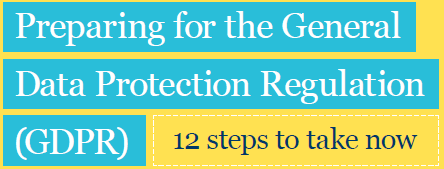Car dealers are being advised to consider 12 important stages now in ensuring their use of customer information complies with the General Data Protection Regulation (GDPR) with a new Information Commissioner’s Office guide.
The ICO says in the guide: “Many of the GDPR’s main concepts and principles are much the same as those in the current Data Protection Act (DPA), so if you are complying properly with the current law then most of your approach to compliance will remain valid under the GDPR and can be the starting point to build from.
“However, there are new elements and significant enhancements, so you will have to do some things for the first time and some things
differently.”
Use the checklist to identify the differences between GDPR and DPA it says.
The 12 steps to take now are:
1. Awareness
You should make sure that decision makers and key people in your organisation are aware that the law is changing to the GDPR. They need to appreciate the impact this is likely to have.
2. Information you hold
You should document what personal data you hold, where it came from and who you share it with. You may need to organise an information audit.
3. Communicating privacy information
You should review your current privacy notices and put a plan in place for making any necessary changes in time for GDPR implementation.
4. Individuals’ rights
You should check your procedures to ensure they cover all the rights individuals have, including how you would delete personal data or provide data
electronically and in a commonly used format.
5. Subject access requests
You should update your procedures and plan how you will handle requests within the new timescales and
provide any additional information.
6. Lawful basis for processing personal data
You should identify the lawful basis for your processing activity in the GDPR, document it and update your privacy notice to explain it.
7. Consent
You should review how you seek, record and manage consent and whether you need to make any changes.
Refresh existing consents now if they don’t meet the GDPR standard.
8. Children
You should start thinking now about whether you need to put systems in place to verify individuals’
ages and to obtain parental or guardian consent for any data processing activity.
9. Data breaches
You should make sure you have the right procedures in place to detect, report and investigate a personal data breach.
10. Data Protection by Design and Data Protection Impact Assessments
You should familiarise yourself now with the ICO’s code of practice on Privacy Impact Assessments as well as the latest guidance from the Article 29
Working Party, and work out how and when to implement them in your organisation.
11. Data Protection Officers
You should designate someone to take responsibility for data protection compliance and assess where this role will sit within your organisation’s structure and governance arrangements. You should consider whether you are required to formally designate a data protection officer.
12. International
If your organisation operates in more than one EU member state (ie you carry out cross-border processing), you should determine your lead data
protection supervisory authority. Article 29 Working Party guidelines will help you do this.
“It is essential to plan your approach to GDPR compliance now and to gain ‘buy in’ from key people in your organisation,” said the ICO.
“You may need, for example, to put new procedures in place to deal with the GDPR’s new transparency and individuals’ rights provisions. In a large or complex business this could have significant budgetary, IT, personnel, governance and communications implications.”
> Read the ICO’s ‘Preparing for the General Data Protection Regulation – 12 steps to take now.’ (pdf)















Login to comment
Comments
No comments have been made yet.